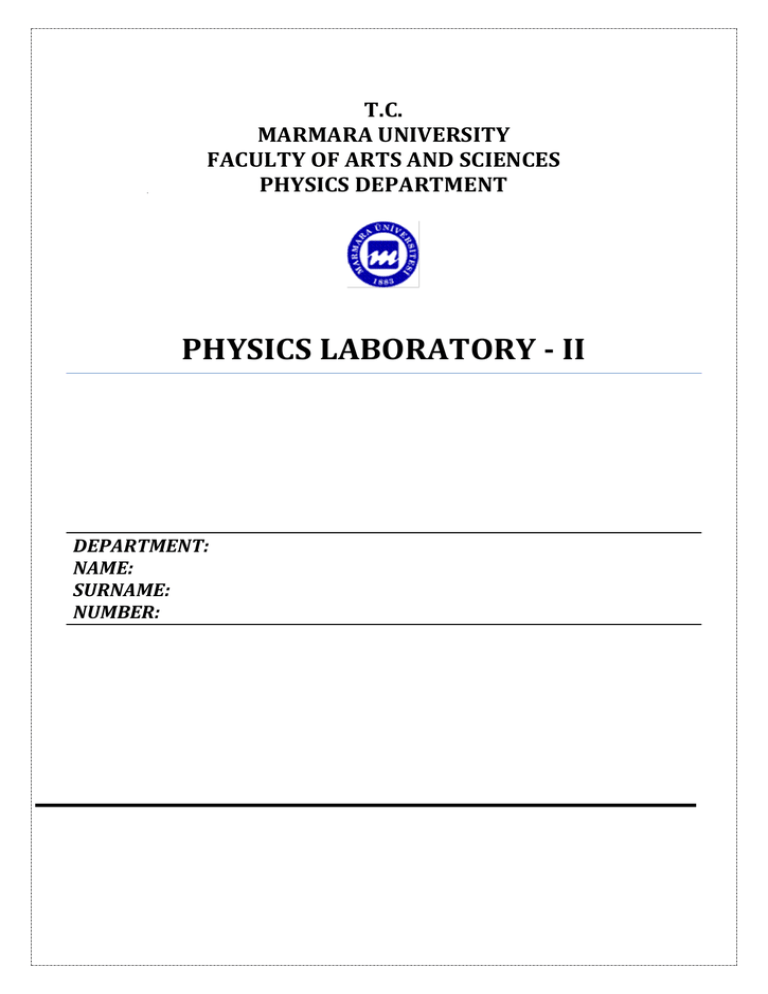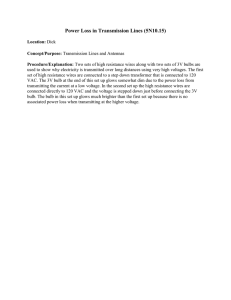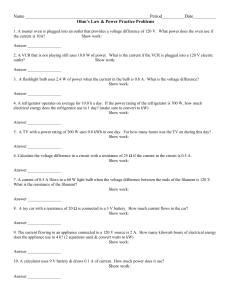PHYSICS LABORATORY
advertisement

T.C. MARMARA UNIVERSITY FACULTY OF ARTS AND SCIENCES PHYSICS DEPARTMENT PHYSICS LABORATORY - II DEPARTMENT: NAME: SURNAME: NUMBER: 2 T.C.MARMARA UNIVERSITY PHYSICS DEPARTMENT PHYSICS LABORATORY –I I MANUAL EXPERIMENT NO: EXPERIMENT NAME: THE DATE: GROUP NO: NAME: NUMBER: DELIVERY TIME: REPORT NOTE: 2 3 EXPERIMENT.3 NON-OHMIC DEVICES IN A CIRCUIT-1 Goal:1.) Investigation of current-voltage characteristic of non-ohmic devices in a circuit Theory: Resistance of non-ohmic devices is not constant and it changes with as a function of current. For example, in one of the non-ohmic devices, filament bulbs, if we rise current, it emit more light and wire in the bulb gets hot. If we draw current-voltage graphic of these devices, we observe a non-linear character. Similarly, dynamic resistance value of this filament is represented by dV/dI. Current-voltage characteristic of another non-ohmic devices, diode, is shown right side and its dynamic resistance is: rd VD I D Static resistance is obtained from specific current that correspond specific DC voltage for static resistance. It is a dynamic resistance that observed around forward voltage point. Current passes in organic diodes and LED’s only one way. They may show high or low resistance depending on polarity of applied voltage. LED’s are conductor for forward voltage and they can conduct very small current(~mA) for reverse voltage. –This small current is known as ‘leakage current’.- LED’s emit light with only forward voltage. Filament bulb is getting hot while current is passing on it so it must be observed that resistance is how depends on temperature. Resistance of bulb is changing with temperature as formula given below. α is temperature coefficient for tungsten. R=Rroom[1+α(T-Troom)] 3 4 Experimental Setup: Apparatus: 1.)Board 2.)Filament bulb 3.)DC voltage source 4.)Digital multimeter 5.)Connectors EXPERIMENTAL SETUP AND MEASUREMENTS: 1.) Build the circuit shown figure above. 2.) Connect a small resistance on the branch that connected to bulb. This prevent heating and burning of the bulb. 3.) Apply max. 6 V DC from power source to circuit and increase the voltage step by step. 4.) Write the values that you read amperemeter and voltmeter that connected to resistance and bulb to the table. Voltage(VR) Voltage(VB) Current(A) 5.) Draw I-V graphics for voltage and current values you read on resistance and bulb. Calculate static resistance via slope of the graphic you get. 6.) Calculate resistance of bulb for maximum voltage. 7.) Calculate power of bulb for the maximum voltage.(P=V2/R) 8.) Calculate resistance of bulb at room temperature using the graphic you drew for bulb.(Find resistance from the point that intersect graphic minimum voltage and current scala.) 9.) Record the temperature of your laboratory. 10.) Calculate temperature coefficient for tungsten wire using resistance value you found for maximum voltage. You can use resistance-temperature formula. Note: Temperature coefficient for tungsten is 4.5 10-3 K-1 . 11.) Calculate your percentage error for temperature coefficient you found. 12.) Interpret your conclusions. 4 5 EXPERIMENT.3 NON-OHMIC DEVICES IN A CIRCUIT-1-NOTES: 5




